



There are a number of health conditions that require additional care and support to maintain health and well-being.
Mae nifer o gyflyrau iechyd y mae angen gofal a chymorth ychwanegol ar eu cyfer i gynnal iechyd a llesiant.
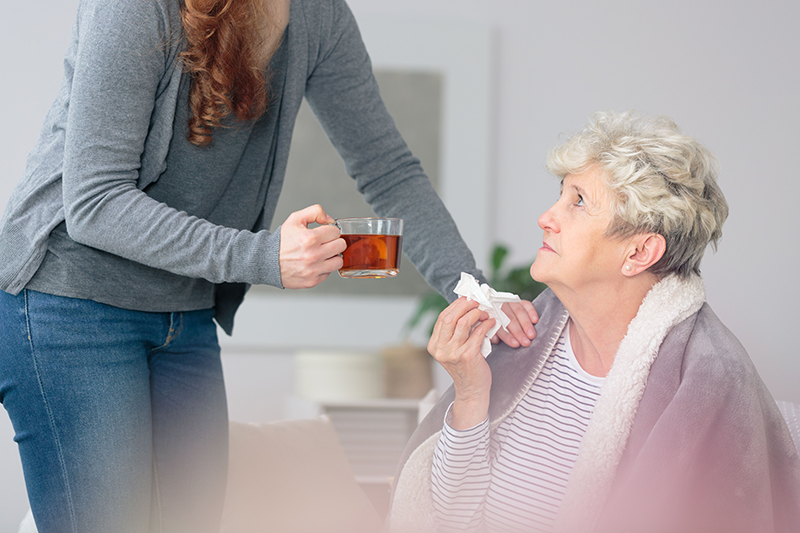
Some of these conditions can be short-term illnesses, such as:
An individual may need support from their GP for medication and guidance about how to manage the illness.
In severe cases, hospitalisation may be needed until the illness has passed.
Further information can be found in this NHS leaflet:
http://www.wales.nhs.uk/sitesplus/documents/866/2012%20-%20When%20shoudl%20I%20worry%20-%20English.pdf
Gall rhai o'r cyflyrau hyn fod yn salwch byrdymor, fel:
Efallai y bydd angen i unigolyn gael cymorth gan ei feddyg teulu ar gyfer meddyginiaeth ac arweiniad ar y ffordd orau o reoli ei salwch.
Mewn achosion difrifol, efallai y bydd angen i unigolyn fod yn yr ysbyty nes bod y salwch wedi mynd.
Ceir rhagor o wybodaeth yn y daflen hon gan y GIG:
http://www.whenshouldiworry.com/resources/When%20should%20I%20worry-Booklet_Wales-WELSH_with%20NHS%20Direct_Oct2016.pdf
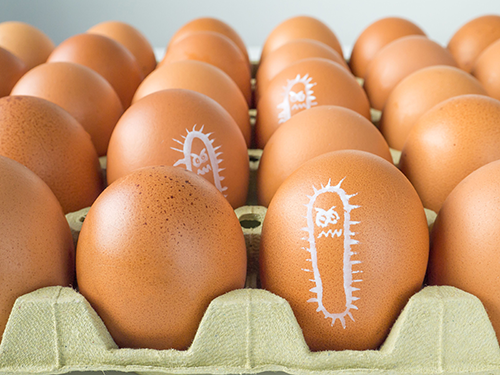
Food poisoning is the common name given to any gastro-intestinal infection caused by the consumption of contaminated food or drink.
The most common types of bacteria found in food are:
It can cause vomiting, diarrhoea and stomach pains among other symptoms.
Further reading:
http://www.wales.nhs.uk/sitesplus/888/page/43714
Gwenwyn bwyd yw'r enw cyffredin sy'n cael ei roi i unrhyw haint gastroberfeddol sy'n cael ei hachosi gan fwyta bwydydd neu ddiodydd wedi'u halogi.
Y mathau mwyaf cyffredin o facteria mewn bwyd yw:
Gall achosi chwydu, dolur rhydd a phoenau yn y stumog ymhlith symptomau eraill.
Darllen pellach:
http://www.wales.nhs.uk/sitesplus/888/tudalen/44185/
A rash is anything that causes the skin to become inflamed or discoloured and changes the skin’s normal appearance.
To find out about the most common types of rashes and their treatment, click on the links below.
Rashes in adults:
http://www.nhsdirect.wales.nhs.uk/livewell/skinrashes/default.aspx?locale=en
Rashes in babies:
https://www.nhsdirect.wales.nhs.uk/encyclopaedia/s/article/skinrashesinbabiesandchildren?locale=en
Brech yw unrhyw beth sy'n peri i'r croen fynd yn llidiog neu newid lliw ac sy'n newid golwg arferol y croen.
Er mwyn cael gwybodaeth am y mathau mwyaf cyffredin o frechau a'u triniaeth, cliciwch ar y dolenni isod.
Brech mewn oedolion:
http://www.nhsdirect.wales.nhs.uk/livewell/skinrashes/default.aspx?locale=cy
Brech mewn babanod:
https://www.nhsdirect.wales.nhs.uk/encyclopaedia/s/article/skinrashesinbabiesandchildren?locale=cy
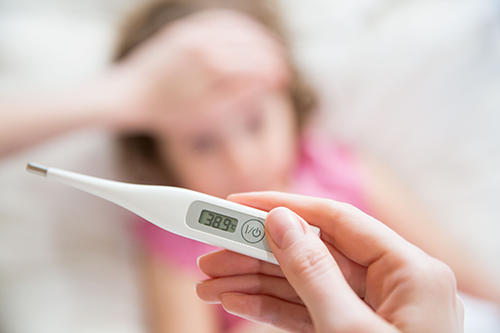
A fever is a high temperature of 38° Celsius or more.
It is the body’s natural defence mechanism for fighting infection. An individual with a temperature will feel hot to touch and will feel sweaty and clammy.
The best way to deal with a high temperature is to get plenty of rest and stay hydrated.
Further reading:
Fever in children: https://www.nhsdirect.wales.nhs.uk/encyclopaedia/f/article/feverinchildren/
Twymyn yw tymheredd uchel o 38° Celsius neu fwy.
Dyma ffordd naturiol y corff o ymladd heintiau. Wrth gyffwrdd ag unigolyn sydd â thymheredd, bydd yn teimlo'n boeth a bydd yn teimlo'n chwyslyd ac yn oer a llaith.
Y ffordd orau o drin tymheredd uchel yw gorffwys ac yfed digon.
Darllen pellach:
Twymyn mewn plant: https://www.nhsdirect.wales.nhs.uk/encyclopaedia/f/article/feverinchildren/
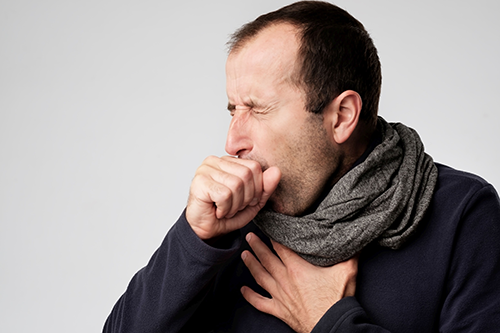
Coughs and colds are the most common of all infections. On average adults will get approximately two colds a year while children can catch up to ten colds in one year.
Coughs and colds are caught by inhaling infected droplets when an individual sneezes or by touching your nose or eyes after being in contact with an individual who has a cold.
The infection will normally last for about four to five days. During this time the body will be fighting the infection so an individual will feel tired and unwell.
Coughs and colds should be treated by getting plenty of rest, keeping warm and drinking plenty of fluids. Paracetamol or ibuprofen should be taken for aches and pains. Children over six can be given over the counter coughs and colds remedies.
The best way to prevent the spread of infection is to cover the nose and mouth when coughing and sneezing and to wash hands and keep surfaces clean.
Peswch ac annwyd yw'r math mwyaf cyffredin o haint. Ar gyfartaledd, bydd oedolion yn cael tua dau ddos o annwyd bob blwyddyn a gall plant ddal hyd at ddeg dos o annwyd mewn blwyddyn.
Rydym yn dal peswch ac annwyd drwy anadlu diferion wedi'u heintio pan fo unigolyn yn tisian neu drwy gyffwrdd â'ch trwyn neu'ch llygaid ar ôl bod mewn cysylltiad ag unigolyn sydd ag annwyd.
Bydd yr haint yn para am bedwar i bump diwrnod fel arfer. Yn ystod yr amser hwn, bydd y corff yn ymladd yr haint, felly bydd yr unigolyn yn teimlo'n flinedig ac yn sâl.
Dylid trin peswch ac annwyd drwy orffwys digon, cadw'n gynnes ac yfed digon o hylif. Dylid cymryd paracetamol neu ibuprofen ar gyfer poenau. Gall plant dros chwech oed gael triniaethau peswch ac annwyd sydd ar gael i'w prynu dros y cownter.
Y ffordd orau o atal haint rhag lledaenu yw gorchuddio'r trwyn a'r geg wrth beswch a thisian, golchi dwylo a chadw arwynebau'n lân.
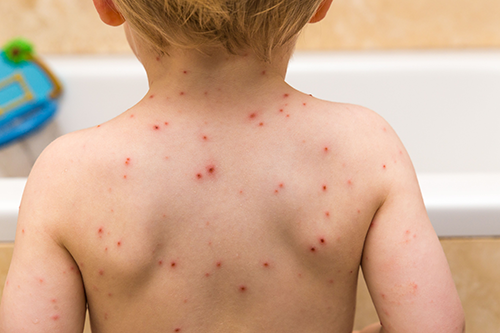
Chicken pox is a highly infectious disease that can be spread through coughs and sneezes or through touching surfaces contaminated with liquid from the blisters.
Individuals with chicken pox will develop clusters of small red spots that will blister after a day or so and become incredibly itchy. It is important not to scratch the spots as this can lead to infection or leave scars.
An individual with chicken pox may feel generally unwell with a high temperature, loss of appetite and feelings of nausea.
Treatment isn’t needed, but the individual should rest, drink plenty of fluid and wear cool, light clothing. Children could wear mittens or socks on their hands to prevent them from scratching. A soothing lotion can be applied to the skin to help calm the itch.
The individual will be contagious until the last blister scabs over, so should stay away from others to prevent a spread of the disease.
Chicken pox in adults can be more severe and can be dangerous for pregnant mothers or individuals with lowered immune systems. They need to ensure that they stay away from an infected person.
Further reading:
http://www.wales.nhs.uk/sitesplus/888/page/43921
http://www.nhsdirect.wales.nhs.uk/livewell/vaccinations/Chickenpox/
Mae brech yr ieir yn glefyd heintus iawn sy'n gallu cael ei ledaenu drwy beswch a thisian neu drwy gyffwrdd ag arwynebau sydd wedi'u halogi â hylif o'r pothelli.
Bydd unigolion â brech yr ieir yn datblygu clystyrau o smotiau bach coch a fydd yn ffurfio pothelli ymhen tua diwrnod ac yn goslyd iawn. Mae'n bwysig peidio â chrafu'r smotiau oherwydd gall hyn arwain at haint neu adael creithiau.
Gall unigolyn â brech yr ieir deimlo'n sâl yn gyffredinol gyda thymheredd uchel, dim awydd am fwyd a theimladau o gyfog.
Nid oes angen triniaeth ond dylai'r unigolyn orffwys, yfed digon a gwisgo dillad ysgafn nad ydynt yn rhy boeth. Gallai plant wisgo menig neu sanau ar eu dwylo er mwyn eu hatal rhag crafu. Gellir rhoi trwyth lleddfol ar y croen er mwyn helpu i leddfu'r cosi.
Bydd yr unigolyn yn heintus nes bod y bothell ddiwethaf yn magu crachen, felly dylai gadw draw oddi wrth eraill er mwyn peidio â lledaenu'r clefyd.
Gall brech yr ieir mewn oedolion fod yn fwy difrifol a gall fod yn beryglus i famau beichiog neu unigolion â systemau imiwnedd gwannach. Mae angen iddynt gadw draw oddi wrth unigolyn sydd wedi'i heintio.
Darllen pellach:
http://www.wales.nhs.uk/sitesplus/888/tudalen/44173/
http://www.nhsdirect.wales.nhs.uk/livewell/vaccinations/Chickenpox/?locale=cy
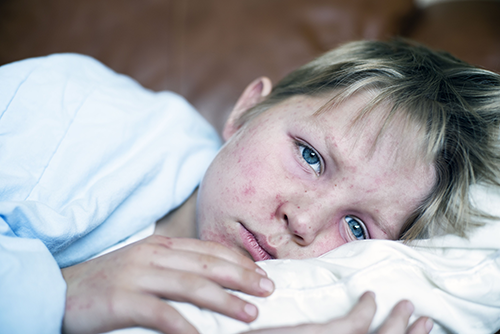
Measles is highly contagious but can be prevented through the MMR vaccination. It is spread by coming into contact with an infected individual, or through inhaling infected droplets from coughs or sneezes.
The symptoms can include cold like symptoms such as a cough and a runny nose and a very high temperature. Individuals may also have sore eyes that are sensitive to light. Small grey spots can appear inside the cheeks with a reddish-brown, botchy rash starting on the neck and spreading to the rest of the body.
There is no treatment for measles, though a doctor should be notified and the individual monitored carefully for signs of complications.
The infected individual should get rest and drink plenty of water. Paracetamol or Ibuprofen can be used to reduce aches and pains. The individual may feel more comfortable in a darkened room, if their eyes are sensitive to light.
Further reading:
http://www.wales.nhs.uk/sitesplus/888/page/43749
Mae'r frech goch yn heintus iawn ond mae modd ei hatal drwy gael brechiad MMR. Mae'r frech yn cael ei lledaenu drwy ddod i gysylltiad ag unigolyn sydd wedi'i heintio, neu drwy anadlu diferion sydd wedi'u heintio pan fo unigolyn yn peswch neu'n tisian.
Gall y symptomau gynnwys symptomau tebyg i annwyd fel peswch a thrwyn sy'n rhedeg a thymheredd uchel iawn. Gall unigolion hefyd gael llygaid llidiog sy'n sensitif i olau. Gall smotiau bach llwyd ymddangos y tu mewn i'r bochau a gall brech frowngoch flotiog ddechrau ar y gwddf cyn lledaenu i weddill y corff.
Nid oes triniaeth ar gyfer y frech goch ond dylid rhoi gwybod i'r meddyg a monitro'r unigolyn yn ofalus rhag ofn y bydd arwyddion o gymhlethdodau.
Dylai'r unigolyn sydd wedi'i heintio orffwys ac yfed digon o ddŵr. Gellir defnyddio paracetamol neu ibuprofen i leddfu poenau. Gall yr unigolyn deimlo'n fwy cyfforddus mewn ystafell dywyll os yw ei lygaid yn sensitif i olau.
Darllen pellach:
http://www.wales.nhs.uk/sitesplus/888/tudalen/44195/
Sort the symptoms and treatments into the correct columns
Didolwch y symptomau a’r triniaethau a’u rhoi yn y colofnau cywir